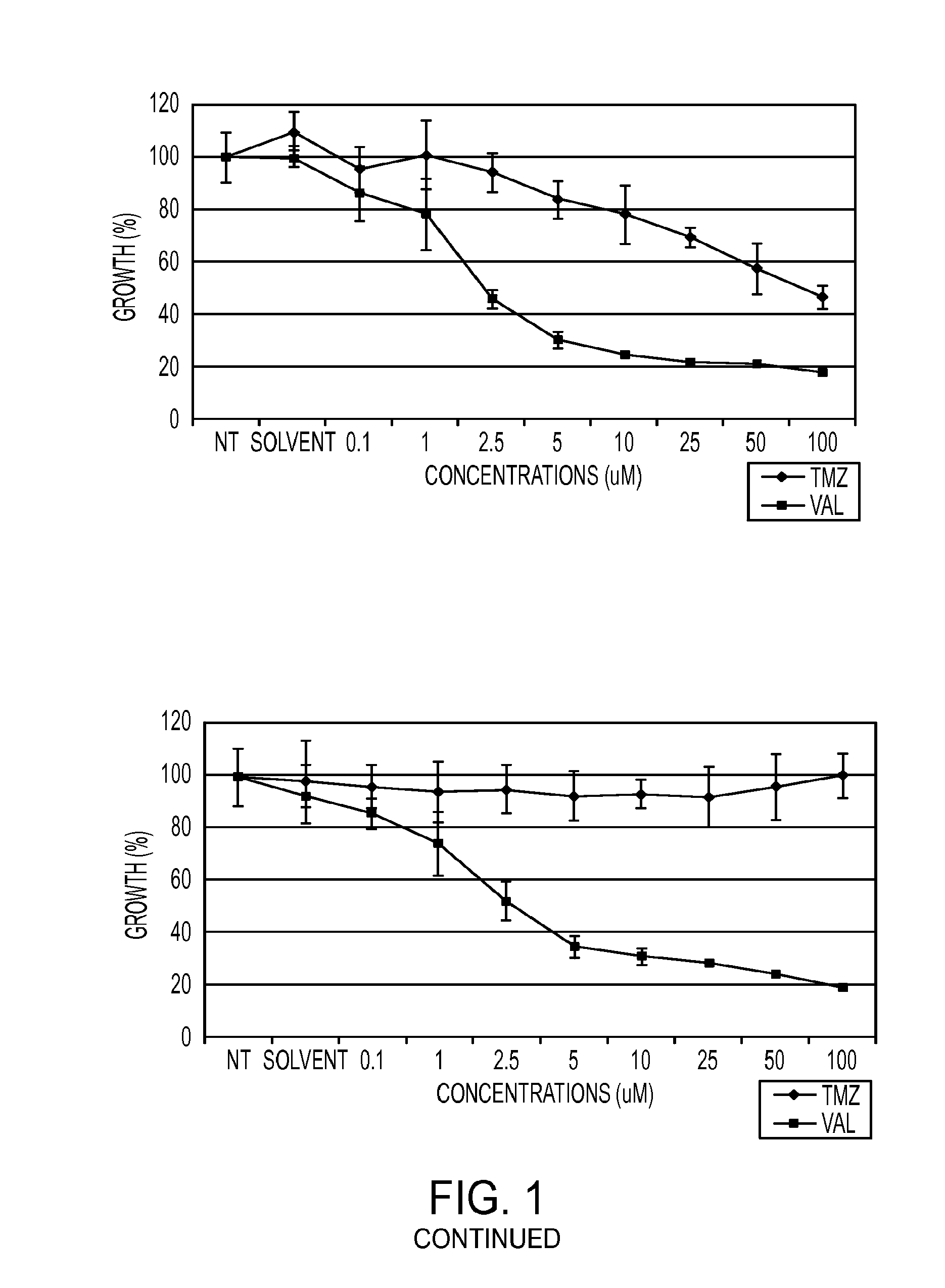Use of dianhydrogalactitol and analogs and derivatives thereof to treat recurrent malignant glioma or progressive secondary brain tumor
a technology of dianhydrogalactitol and analogs, which is applied in the direction of instruments, drug compositions, peptide/protein ingredients, etc., can solve the problems of inability to failure or disappointment of chemical agents in human clinical trials, and inability to effectively meet preclinical testing and federal regulatory requirements for clinical evaluation, etc., to improve the utility of chemical agents with suboptimal performance, improve the effect of dose determination and schedul
- Summary
- Abstract
- Description
- Claims
- Application Information
AI Technical Summary
Benefits of technology
Problems solved by technology
Method used
Image
Examples
example 1
Use of Dianhydrogalactitol to Treat Patients with Recurrent Malignant Glioma or Progressive Secondary Brain Tumor
[1319]Tumors of the brain are among the most challenging malignancies to treat. Median survival for patients with recurrent disease is <6 months for glioblastoma multiforme (GBM). Central Nervous System (CNS) metastases have evolved as a major contributor to cancer mortality based on improvements in systemic therapies that cannot reach tumors spreading to the brain.
[1320]Front-line systemic therapy is temozolomide but resistance due to O6-methylguanine-DNA-methyltransferase (MGMT) activity is implicated in poor outcomes. Such resistance vastly reduces survival.
[1321]Dianhydrogalactitol is a first-in-class bifunctional N7 DNA-alkylating agent that readily crosses the blood-brain barrier and accumulates in brain tissue. Dianhydrogalactitol causes interstrand DNA crosslinks at the N7-guanine (E. Institóris et al., “Absence of Cross-Resistance Between Two Alkylating Agents: B...
example 2
Dianhydrogalactitol Inhibits the Growth of Glioma Stem and Non-Stem Cultures, Including Temozolomide-Resistant Cell Lines, In Vitro and In Vivo
[1341]Dianhydrogalactitol inhibits the growth of glioma stem and non-stem cultures, including temozolomide-resistant cell lines, in vitro and in vivo.
[1342]The standard of care for glioblastoma multiforme (GBM) patients is surgical resection followed by temozolomide (TMZ) and irradiation (XRT). However, TMZ-resistance has emerged as a significant unmet medical need, as DNA repair enzyme O6-methylguanine DNA methyltransferase (MGMT) removes the methyl-group adducts caused by TMZ. Dianhydrogalactitol (VAL-083) is a structurally unique alkylating agent causing DNA crosslinks at N7 position of guanine. Because VAL-083's N7 adducts are not subject to MGMT mediated repair, it may be an effective chemotherapeutic in the treatment of TMZ-resistant GBM. VAL-083 crosses the blood brain barrier and accumulates in brain tumor tissue. We have recently sho...
example 3
Phase I / II Study of Dianhydrogalactitol in Patients with Recurrent Malignant Glioma
[1383]Glioblastoma multiforme (GBM) is the most common and deadly form of human brain cancer. Median survival for patients with recurrent GBM is 6-methylguanine-DNA-methyltransferase (MGMT) activity is implicated in poor prognoses. Dianhydrogalactitol (VAL-083) is a structurally unique bi-functional DNA alkylating agent that crosses the blood-brain barrier and accumulates in brain tumor tissue. In recent in vitro studies, VAL-083 overcame resistance to MGMT and demonstrated cytotoxic activity against GBM cell lines, as well as GBM cancer stem cells, and was shown to act as a radiosensitizer. Previous clinical trials suggest that VAL-083 has activity against a range of tumors, including GBM. In light of extensive safety data and previous studies, NCI-sponsored studies in GBM achieved promising results with limited toxicity using a dosing regimen of 25 mg / m2 / day for five days every five weeks. The prese...
PUM
| Property | Measurement | Unit |
|---|---|---|
| Time | aaaaa | aaaaa |
| Time | aaaaa | aaaaa |
| Time | aaaaa | aaaaa |
Abstract
Description
Claims
Application Information
 Login to View More
Login to View More - R&D
- Intellectual Property
- Life Sciences
- Materials
- Tech Scout
- Unparalleled Data Quality
- Higher Quality Content
- 60% Fewer Hallucinations
Browse by: Latest US Patents, China's latest patents, Technical Efficacy Thesaurus, Application Domain, Technology Topic, Popular Technical Reports.
© 2025 PatSnap. All rights reserved.Legal|Privacy policy|Modern Slavery Act Transparency Statement|Sitemap|About US| Contact US: help@patsnap.com



